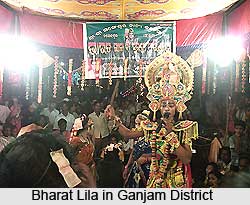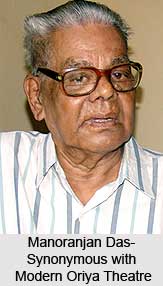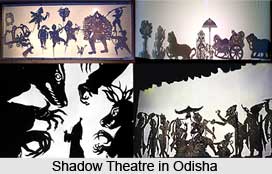 The Oriya theatre comprised of a lot of variety. The range starts from puppetry i.e. Kundhei Nata, Sakhi-kundhei Nata, Ravana Chhaya to balladry i.e. Daskathia, Pala, devotional ritual i.e. Danda Nata, Bandi Nata, etc. It diverse forms of Lila i.e. Yatra, Dhanu Yatra, Rahasa, Bharat Lila, mythological presentations such as Prahlada Nataka, Suanga, masked dance-drama i.e. Chhau and Desia Nata, folk dance i.e. Chaiti Ghoda Nata, and satire such as Mughal Tamsha. Processionals like Sahi Yatra dedicated to Rama, as well as Ramlila, are staged with much pomp and ceremony during Ram Navami. The above categories often overlap. No simple classification is possible. However, all these forms are fast receding owing to rapid urbanization and the traditional elements in them are disappearing. Young audiences are no longer interested in them, though some dramatists now reintroduce them to make their own work more colourful.
The Oriya theatre comprised of a lot of variety. The range starts from puppetry i.e. Kundhei Nata, Sakhi-kundhei Nata, Ravana Chhaya to balladry i.e. Daskathia, Pala, devotional ritual i.e. Danda Nata, Bandi Nata, etc. It diverse forms of Lila i.e. Yatra, Dhanu Yatra, Rahasa, Bharat Lila, mythological presentations such as Prahlada Nataka, Suanga, masked dance-drama i.e. Chhau and Desia Nata, folk dance i.e. Chaiti Ghoda Nata, and satire such as Mughal Tamsha. Processionals like Sahi Yatra dedicated to Rama, as well as Ramlila, are staged with much pomp and ceremony during Ram Navami. The above categories often overlap. No simple classification is possible. However, all these forms are fast receding owing to rapid urbanization and the traditional elements in them are disappearing. Young audiences are no longer interested in them, though some dramatists now reintroduce them to make their own work more colourful.
In 1872, students of the Catholic Mission School in Cuttack enacted an English play, perhaps by Oliver Goldsmith. This was based on a temporary proscenium stage. It was well received by the audience. But it took another three years for Oriya drama to reach the proscenium proper. The establishment of a permanent stage in 1875 by Jaga Mohan Lala in Mahanga village, Cuttack district, gave birth to modern Oriya theatre. Lala also wrote the first Oriya social drama, Babaji i.e. `The Holy Man`. Ramshankar Ray`s first play, Kanchi-Kaveri, was presented in 1881 by an amateur group in Cuttack. Other early dramatists included Kampal Mishra, Bhikari Charan Patnaik, and Godavarish Mishra. Gradually, interest for this kind of show grew among people, but Cuttack`s first purpose-built theatre, Basanti Pandal, arose only in 1910. Meanwhile, permanent stages were erected by two feudal chiefs namely Bira Bikram Dev`s Bikram Theatre at Khariar and Padmanav Rangalay at Paralakhemundi in Gajapati district.
 This was somewhat a raw beginning of the Oriya theatre. Different Professional troupes had emerged later on. One was owned by Banamali Pati, doing plays by Aswini Kumar Ghose but mostly as touring parties and without any permanent theatres. This state of affairs continued till the 1940s, when almost simultaneously two professional theatres came up in Cuttack and a third in Puri. Kali Charan Patnaik, an eminent dramatist, already headed a touring group that he converted into a company under a new name, Orissa Theatre, and housed in a permanent building (1942) at Banka Bazar, Cuttack. Also sensing the changing tastes of the time, he switched to social plays. Similarly, a musical-drama troupe owned by Somnath Das turned into Annapurna Theatre, with branches in Puri and Cuttack. The companies in Cuttack competed to win over audiences. Memorable plays like Girls` School in 1942, Chumban i.e. `Kiss` in 1942, Bhata i.e. `Rice` in 1944, and Mulia i.e. `Labourer` in 1946 were the outcome of this competition.
This was somewhat a raw beginning of the Oriya theatre. Different Professional troupes had emerged later on. One was owned by Banamali Pati, doing plays by Aswini Kumar Ghose but mostly as touring parties and without any permanent theatres. This state of affairs continued till the 1940s, when almost simultaneously two professional theatres came up in Cuttack and a third in Puri. Kali Charan Patnaik, an eminent dramatist, already headed a touring group that he converted into a company under a new name, Orissa Theatre, and housed in a permanent building (1942) at Banka Bazar, Cuttack. Also sensing the changing tastes of the time, he switched to social plays. Similarly, a musical-drama troupe owned by Somnath Das turned into Annapurna Theatre, with branches in Puri and Cuttack. The companies in Cuttack competed to win over audiences. Memorable plays like Girls` School in 1942, Chumban i.e. `Kiss` in 1942, Bhata i.e. `Rice` in 1944, and Mulia i.e. `Labourer` in 1946 were the outcome of this competition.
Bharati Theatre was another professional party that contributed a lot to Oriya theatre. This appeared in Cuttack in the early 1940s, resulting briefly in three-way rivalry. Besides, there were two touring troupes, led by Govinda Chandra Surdeo and Mohansundar Deva Goswami. After a decade of successful and regular productions Orissa Theatre closed down in 1949, but both branches of Annapurna Theatre continued. The short-lived Rupashri Theatre emerged in Cuttack in 1951, followed by Janata Theatre and Kalasri Theatre. This put on daily shows alongside those of Annapurna. This was the only example of its kind in India.
 All these professional companies needed a regular supply of good drama to support Oriya theatre to stand apart. Hence new plays were written, playwrights encouraged, and a rich and healthy tradition of staged drama was created. This movement was alive for almost two decades. Critics identify this period as the `golden age` of modern Oriya theatre and Oriya drama. A group of talented dramatists like Ramchandra Mishra, Bhanja Kishore Patnaik, Gopal Chhotray, Ananda Sankar Das, and Kamal Lochan Mohanty were associated with these parties. Their plays dealt with universal values such as exploring human qualities and follies, various social questions, political issues, the impact of economic and industrial revolutions, and many other contemporary problems. However, being commercial, the theatres did not give much scope for experimentation. They had to cater mainly to the demands of their middle-class viewer ship which, like its counterparts elsewhere, expected entertainment from the stage.
All these professional companies needed a regular supply of good drama to support Oriya theatre to stand apart. Hence new plays were written, playwrights encouraged, and a rich and healthy tradition of staged drama was created. This movement was alive for almost two decades. Critics identify this period as the `golden age` of modern Oriya theatre and Oriya drama. A group of talented dramatists like Ramchandra Mishra, Bhanja Kishore Patnaik, Gopal Chhotray, Ananda Sankar Das, and Kamal Lochan Mohanty were associated with these parties. Their plays dealt with universal values such as exploring human qualities and follies, various social questions, political issues, the impact of economic and industrial revolutions, and many other contemporary problems. However, being commercial, the theatres did not give much scope for experimentation. They had to cater mainly to the demands of their middle-class viewer ship which, like its counterparts elsewhere, expected entertainment from the stage.
Gradually, remarkable changes in the tastes and attitudes of the audience due to social transformations alienated Oriya theatre. Some leading actors like Babi successfully negotiated both the worlds of theatre and cinema to make Oriya theatre rather contemporary. However, by the beginning of the 1970s, all commercial companies had closed down, putting an end to an extraordinary dramatic tradition in this region. No professional theatre has come up in Orissa since then.
Only Manoranjan Das, who was a talented dramatist, visualized the changing atmosphere during the heyday of professionalism. Although he started his dramatic career writing for professional parties, he constituted a group called United Artists in 1950 to stage his first experimental play, Agami i.e. `Advent`. This brought him applause both inside and outside Orissa while making Oriya theatre to once again showcase the shimmer. For the first time the local audience noticed an Ibsenian style on stage and a novel theme based on psychological realism. This impressed the elite and the idiom was accepted. Afterwards, Das always depended on amateur groups to perform his provocative works, such as Sagara manthan i.e. `Churning of the Ocean`, Banahamsi i.e. `Wild Goose` and Amritasya putrah i.e. `Immortal Son`. He started the group-theatre movement in Orissa, which soon occupied the prominent place in Oriya theatre.
Srujani was a distinguished group in Cuttack which again contributed a lot to the contour pf Oriya theatre. It created history by staging a number of experimental plays during its short life including the above three by Das. This was well received by theatre goers. Biswajeet Das wrote Pratapgadare dudin i.e. `Two Days in Pratapgarh` for them. Srujani is credited with changing the taste of audiences. Encouraged by the success of group theatre and the altering style of drama, young writers grew interested in the new movement. Their plays reflected the changing lifestyle and its agony, the hypocrisy, self-centredness, and possessiveness due to insecurity. For the first time, Oriya theatre established a direct, distinct, and strong bridge with Western drama, and characters, situations, and incidents alien to traditional Oriya society crept in. The new authors totally discarded the rural background that had prevailed in Oriya drama so far.
For the last two decades Cultural Academy has organized annual drama competitions. This has again helped Oriya theatre in taking those strides towards maturity. In the absence of professional theatre in Orissa, amateur groups form the only source of hope for Oriya theatre.
Lately, Oriya dramatists have tried to return to their roots through various folk forms. They have reintroduced music, dance, earthy humour, and emotional outbursts. Myth, legend, and history are used to add colour to Oriya theatre.
Contemporary Oriya theatre claims to be the progeny of Yatra, once popularized by pioneers like Baishnab Pani and Balakrishna Mohanty. Presently these entertainments, originating mostly in coastal Orissa, run day after day to packed houses and do roaring business. A good number of `opera parties` such as Tulasi Gananatya, Janata Opera, Sibani Opera, Uttarkul Opera, Uttarayani Opera, Parbati Gananatya, Banirampur Opera, Orissa Opera, and Tarini Opera tour throughout the state and Oriya-dominated parts of neighbouring states. Crores of rupees are invested with alluring returns.
Oriya theatre in the recent day has gained a massive alteration. Artists and dramatists are hired with the assurance of good remuneration. Actresses have been introduced. Modern theatre techniques are used and multi-stage systems have replaced single stages. To attract crowds, explicit scenes of violence, rape, and murder in the style of commercial films are performed.




















